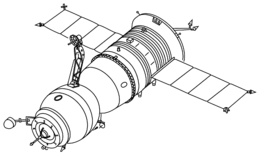Soyuz-T
 Soyuz-T spacecraft | |
| Manufacturer | Korolev |
|---|---|
| Country of origin | USSR |
| Operator | Soviet space program |
| Applications | Carry threecosmonautstoSalyutandMirspace stations and back |
| Specifications | |
| Regime | Low Earth orbit |
| Production | |
| Status | Out of service |
| Launched | 18 |
| Maiden launch | 4 April 1978 Kosmos 1001 |
| Last launch | 16 March 1986 Soyuz T-15 |
| Related spacecraft | |
| Derived from | Soyuz 7K-TM Soyuz 7K-T Soyuz 7K-S |
| Derivatives | Soyuz-TM |
TheSoyuz-T(Russian:Союз-T,Union-T) spacecraft was the third generationSoyuz spacecraft,in service for seven years from 1979 to 1986. TheTstood for transport (транспортный,Transportny). The revised spacecraft incorporated lessons learned from theApollo Soyuz Test Project,Soyuz 7K-TMandMilitary Soyuz.
The Soyuz-T was a major upgrade over previous Soyuz spacecraft, sporting solid-state electronics for the first time and a much more advanced onboard computer to help overcome the chronic docking problems that affected cosmonauts during space station missions. In addition,solar panelsreturned, allowing the Soyuz-T to fly up to 11 days independently as well as a redesigned propulsion system, theKTDU-426.Finally, it could carry three cosmonauts with pressure suits.
Missions
[edit]Between 1979 and 1986, a total of 18 Soyuz T spacecraft were launched intoLEO,13 of which carried cosmonauts to and from the space stationsSalyut 6,Salyut 7,andMir.[1]
| Mission | Crew | Launch | Landing | Duration | Notes |
|---|---|---|---|---|---|
| Kosmos 1001 | None | 4 Apr 1978 | 15 Apr 1978 | 11 days | [2] |
| Kosmos 1074 | None | 31 Jan 1979 | 1 Apr 1979 | 60 days | Last Soyuz spacecraft with aKosmosdesignation[2] |
| Soyuz T-1 | None | 16 Dec 1979 | 25 Mar 1980 | 100 days | Uncrewed test flight toSalyut 6[2] |
| Soyuz T-2 | Salyut 6EP-6: |
5 Jun 1980 | 9 Jun 1980 | 4 days | Crewed test flight[3] |
| Soyuz T-3 | Salyut 6EO-5: |
27 Nov 1980 | 10 Dec 1980 | 13 days | First Soyuz mission with a three cosmonaut crew since the fatal flight ofSoyuz 11[4] |
| Soyuz T-4 | Salyut 6EO-6: |
12 Mar 1981 | 26 May 1981 | 75 days | [5] |
| Soyuz T-5 | Salyut 7EO-1: |
13 May 1982 | 27 Aug 1982 | 106 days | Both Berezovoy and Lebedev returned to Earth aboardSoyuz T-7after 211 days in space[6] |
| Soyuz T-6 | Salyut 7EP-1: |
24 Jun 1982 | 2 Jul 1982 | 8 days | Chrétien becomes the first French citizen in space[7] |
| Soyuz T-7 | Salyut 7EP-2: |
19 Aug 1982 | 10 Dec 1982 | 113 days | Savitskaya becomes the second woman in space afterValentina Tereshkovain 1963. All cosmonauts returned to Earth aboardSoyuz T-5after 8 days in space[8] |
| Soyuz T-8 | 20 Apr 1983 | 22 Apr 1983 | 2 days | Failed to reachSalyut 7after its Igla docking system was damaged during launch[9] | |
| Soyuz T-9 | Salyut 7EO-2: |
27 Jun 1983 | 23 Nov 1983 | 149 days | [10] |
| Soyuz T-10-1 | 26 Sept 1983 | 5 minutes and 13 seconds | Failed to reachSalyut 7after its carrier rocket caught fire and exploded, thus activating its launch escape system[11] | ||
| Soyuz T-10 | Salyut 7EO-3: |
8 Feb 1984 | 11 Apr 1984 | 63 days | All cosmonauts returned to Earth aboardSoyuz T-11after 237 days in space[12] |
| Soyuz T-11 | Salyut 7EP-3: |
3 Apr 1984 | 2 Oct 1984 | 182 days | Sharma becomes first Indian citizen in space. All cosmonauts returned to Earth aboardSoyuz T-10after 8 days in space[13] |
| Soyuz T-12 | Salyut 7EP-4: |
17 Jul 1984 | 29 Jul 1984 | 12 days | [14] |
| Soyuz T-13 | Salyut 7EO-4a: |
6 Jun 1985 | 26 Sept 1985 | 112 days | Repaired the crippled station during their stay. Savinykh returned to Earth aboardSoyuz T-14after 168 days in space[15] |
| Soyuz T-14 | Salyut 7EO-4b: Salyut 7EP-5: |
17 Sept 1985 | 21 Nov 1985 | 65 days | Grechko returned to Earth aboardSoyuz T-13after 9 days in space. Mission ended prematurely after Vasyutin fell ill aboard the station[16] |
| Soyuz T-15 | Salyut 7EO-5/MirEO-1: |
13 Mar 1986 | 16 Jul 1986 | 125 days | Visited bothSalyut 7andMir,the only crewed spaceflight to visit two space stations simultaneously[17] |
References
[edit]- ^David S. F. Portree (1995).Mir Hardware Heritage(PDF).NASA.Archived(PDF)from the original on 26 March 2023.
- ^abcMark Wade."Soyuz T".Encyclopedia Astronautica.Retrieved25 May2024.
- ^"Spaceflight mission report: Soyuz T-2".SPACEFACTS.de.Retrieved5 June2024.
- ^"Spaceflight mission report: Soyuz T-3".SPACEFACTS.de.Retrieved5 June2024.
- ^"Spaceflight mission report: Soyuz T-4".SPACEFACTS.de.Retrieved5 June2024.
- ^"Spaceflight mission report: Soyuz T-5".SPACEFACTS.de.Retrieved5 June2024.
- ^"Spaceflight mission report: Soyuz T-6".SPACEFACTS.de.Retrieved5 June2024.
- ^"Spaceflight mission report: Soyuz T-7".SPACEFACTS.de.Retrieved5 June2024.
- ^"Spaceflight mission report: Soyuz T-8".SPACEFACTS.de.Retrieved5 June2024.
- ^"Spaceflight mission report: Soyuz T-9".SPACEFACTS.de.Retrieved5 June2024.
- ^"Suborbital spaceflight mission report: Soyuz T-10A".SPACEFACTS.de.Retrieved5 June2024.
- ^"Spaceflight mission report: Soyuz T-10".SPACEFACTS.de.Retrieved5 June2024.
- ^"Spaceflight mission report: Soyuz T-11".SPACEFACTS.de.Retrieved5 June2024.
- ^"Spaceflight mission report: Soyuz T-12".SPACEFACTS.de.Retrieved5 June2024.
- ^"Spaceflight mission report: Soyuz T-13".SPACEFACTS.de.Retrieved5 June2024.
- ^"Spaceflight mission report: Soyuz T-14".SPACEFACTS.de.Retrieved5 June2024.
- ^"Spaceflight mission report: Soyuz T-15".SPACEFACTS.de.Retrieved5 June2024.


